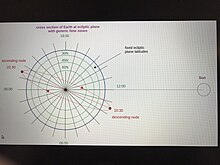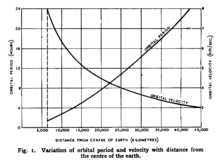Sun-synchronous orbit
As sun -synchronous orbit or sun-synchronous orbit (also sun synchronous orbit , abbreviated SSO ) is called an orbit around a planet whose orbital plane undergoes the same rotation change as the circled planets around the sun . As a result, the orbital plane has a fixed angle to the planet-sun line.
For the earth which means the orbital plane of that satellite in one year ( orbital period of the Earth around the Sun) once around the Earth rotates.
A planet-synchronous orbit around the sun , e.g. B. in an orbit given by the Lagrange points .
properties
Without interference , a satellite orbits the earth with constant angular momentum on a plane that is stationary in space (purple curve in the figure above). However, the flattening of the earth exerts a torque and leads to a shift in the right ascension of the ascending node . In orbits against the earth's rotation (i.e. inclinations > 90 °) this precession acts in the same direction as the earth's rotation .
The precession is greater, the lower the inclination and the flight altitude (see calculation below). With a suitable choice of inclination and altitude, the orbit shifts just enough that it circles the earth once a year (green curve in the figure above).
In an SSE orbit, the orbital plane of the satellite always passes a point on the surface of the planet at the same local time , if the geographical latitude of the location is within the range that is limited by the inclination of the orbit. Due to the constant local time of the overflight, observations from different days can be easily compared with each other, since with a similar angle of incidence of the sun rays (not: identical angle of incidence ...; because of the additional influence of the seasons on the position of the sun) the reflection of surfaces hardly changes.
As a new two-line element set which puts local time ascending node (English Local Time of Ascending Node , LTAN) local time overflight firmly.
If the satellite moves along the twilight zone (morning or evening hour, English Dusk-Dawn ) at 9 h LTAN, the height of objects can be derived from the length of the shadow cast on optical recordings. If the satellite also orbits the earth in such a way that it does not pass the earth's shadow (around 6 h LTAN, inclination greater than 101.45 °), it can be continuously supplied with energy by solar cells . Batteries on board are then only required for the start phase or if position control is lost.
Application examples:
- Weather satellites such as TIROS , Nimbus , DMSP , METOP
- Earth exploration satellites such as Landsat , ERS , Sentinel-2
- Solar observation satellites such as ACRIMSat , TRACE , Hinode
- Research satellites such as DLR-TUBSAT
- some space telescopes like Infrared Astronomical Satellite , Wide-Field Infrared Survey Explorer .
calculation
The precession of a sun-synchronous orbit is calculated as:
With:
- the radius of the earth at the equator (6378 km)
- the radius of the satellite orbit
- the expansion coefficient of the ground potential (1.082 × 10 -3 ); it describes the mass of the earth at the equator, which causes the precession and the displacement of the right ascension of the ascending node.
- the angular velocity of the satellite
- the inclination .
If one takes into account the dependence of the orbital speed on the orbit radius (second figure), the relationship between inclination and orbit height shown in the first figure results :
- at an inclination of 96 ° the torque on the orbital angular momentum is very small; the satellite would have to orbit the earth on an SSE lower than 100 km. Disturbances from the earth's atmosphere have a strong effect at this low orbit . Therefore, SSE orbits with such a small inclination (and an altitude of up to 6000 km) are of no practical importance.
- Instead, earth observation satellites fly at an inclination between 98 ° and 99 °, because the associated altitude of 650 km to 900 km is a good compromise between interference from the earth's atmosphere and the distance to the objects being observed on earth. If you insert these values in the above formula and adjust them (or read from the second diagram), you get a rotation speed of approx. 7.5 km / s for a realistic sun-synchronous orbit, which corresponds to approx. 14.5 orbits around the earth per day or approx. 1:40 h per cycle.
See also
- Polar orbit : runs over the poles, inclination close to 90 °, but not necessarily sun-synchronized
Individual evidence
- ↑ http://design.ae.utexas.edu/mission_planning/mission_resources/orbital_mechanics/Sun_Synchronous_Orbits.pdf
Web links
- Hillhouse, James D. (1999): "Sun Synchronous Orbits for the Earth Solar Power Satellite System" (pdf, eng; 32 kB)
- Unknown (1999): "Orbital Mechanics with Numerit - Sun-synchronous Orbit Design" (pdf, eng; 14 kB)













